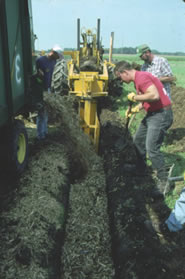Advancing constructed wetlands and denitrifying bioreactors to abate edge-of field nitrogen losses
Alternative systems to reduce nitrogen from artificially drained fields
Situation: Water removed from fields through tile drainage systems is often very high in nitrogen (N), primarily in the form of nitrate. These high nitrate concentrations can exceed the maximum contaminant level for drinking water and can also contribute to hypoxia problems in surrounding waters. Alternative drainage systems may hold promise in reducing nitrate from these agricultural landscapes.
Actions: A field study by USDA- Agricultural Research Service compared the nitrate losses from a conventional drainage system (tile drains) to losses from two alternative systems: deep tile drainage and a denitrification wall (wood chip bioreactor) system tied into the tile drainage network. The study was conducted on a research farm at Iowa State University using four plots for each of the three drainage systems.
 Take-home message:
Take-home message:
- Over a 5 year period, water draining through the denitrification wall had significantly lower nitrate concentrations than the water from the conventional drainage system (55% reduction).
- The deep tile drainage did not have lower nitrate concentrations when compared to the conventional drainage system.
- The use of denitrification walls can be a highly effective method for managing N contamination in drainage waters.
For more information:
- Jaynes et al. 2008. In Situ Bioreactors and Deep Drain-Pipe Installation to Reduce Nitrate Losses in Artificially Drained Fields. Journal of Environmental Quality 37:429–436
- Email Dr. Dan Jaynes at dan.jaynes@ars.usda.gov